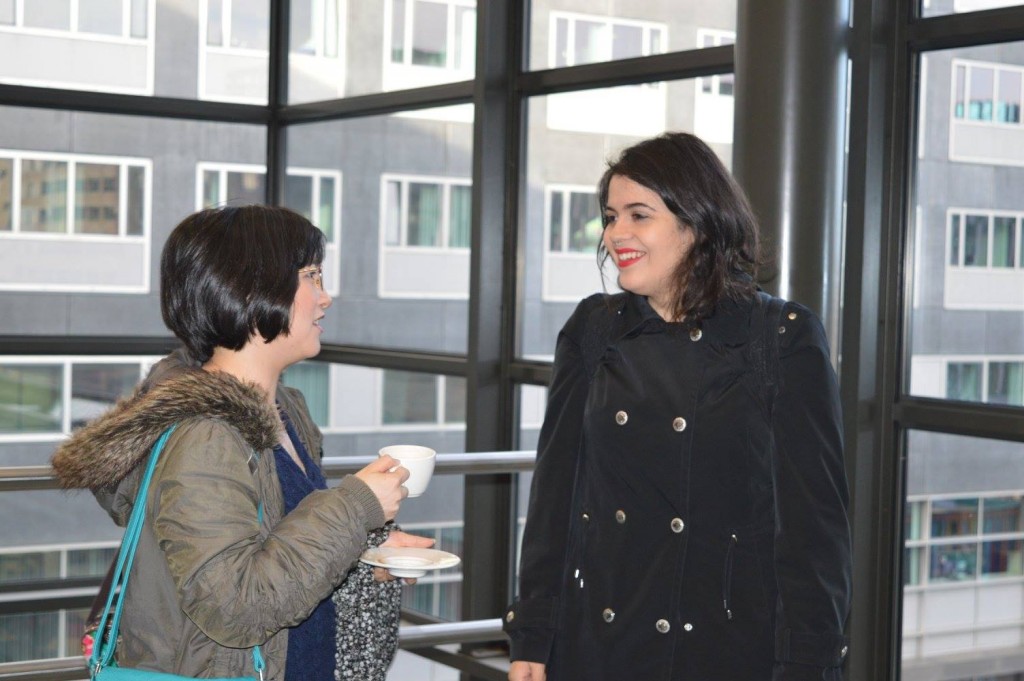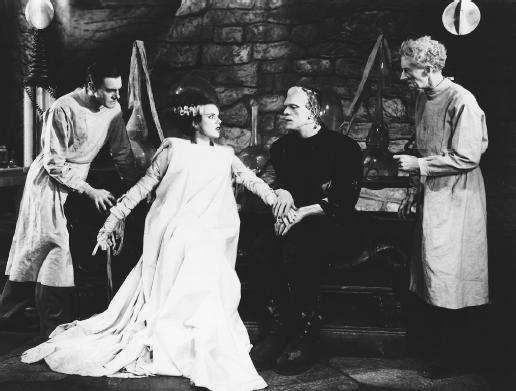Last December I had the opportunity to attend a pre-show talk with the directors of Punchdrunk’s The Drowned Man. During this talk I managed to ask a question about the participatory nature of the production, and there were some other interesting tidbits related to documentation that were drawn out during the Q&A. I had been meaning to transcribe the event, but, as is always the way, RL (“real life”) got in the way, until I was directed to a full transcript already posted on Tumblr.
Below I have posted some excerpts from the talk that touch upon LIS matters specifically. The questions asked are by myself and other audience members, and are put to Felix Barrett and Maxine Doyle, the director and director/choreographer respectively. The session was moderated by academic and immersive specialist, Josephine Machon. Please note that this post will contain spoilers for those who are sensitive about the show being spoiled for them.
Many thanks to Ami from At the gates guarded by horses for getting round to doing what I didn’t. To read the full transcript, go here.
[I ask about the participatory aspects of the show, and how much the fan activity around The Drowned Man was planned from the outset].
“To ask about the audience, because they’re very much an actor or actors in itself, and the participation and the performance and the kind of agency that they have – I wanted to ask how much that was intended? Because also the audience is a participant away from the performance as well, I mean they carry on world-building, on Facebook and Tumblr and they really become attached to the characters, and I was wondering how much that’s caught your attention?”
Felix: We’re trying to empower the audience, we’re trying to give them control. The whole thing’s to make them active so it’s theirs. So it’s incredible, we’re overjoyed when we see the Tumblr thing and just the ideas and response that people have to the work. And it actually provokes us to think of more ways that we could infiltrate the real world and we can give back to people who – I think the grand plan is ‘how can you break out of walls? how can you free yourself from going to the theatre for three hours in one space?’ All of this stuff that’s happening is all part of a dialogue that’s going to lead to something new and exciting.
Then within the show…
Maxine: It’s what I was saying earlier, they fuel the dynamic of the narrative. So, in the show, when William and Wendy start having episodes then the audience which was invisible to them then become visible. They see ten, twenty, fifty, a hundred apparitions and they become their demons, so the reality of that dialogue is really present. And also it’s exciting seeing an audience flying down the corridor chasing a character. That sort of sense of commitment and desire to be part of that story and be part of that world is kind of weird but sort of wonderful at the same time.
Felix: It’s sort of like a modern-day Greek chorus. They’re judging, they’re the Furies, they’re watching over, they’re casting their vote. My favourite bits in the show are when they slip from being invisible, safe, protected behind their mask, and suddenly be exposed because a character has reached a state of frenzy whereby they’re suddenly – imagine I mean sometimes it feels like we’re having a conversation, the three of us. And then you realise there are eighty of you… And it’s empowering as well.
Josephine: So why do you choose the white mask as well as the black mask, is there any point to these? [Audience members wear white masks. Ushers wear black masks].

Maxine: Well the point of the characters, well they’re not characters, they’re our stewards and ushers, that wear the black masks, and they’re there for your safety and the safety and protection of the cast. They wear black masks and can just disappear really into a dark corner. And they’re just there so people feel secure, because I think when they’re – one of the things that makes this work really exciting and allows us to take risks is that we know it’s safe, we know that there’s order and structure and rigor in the chaos of it. And then the white masks, well they offer a very different function…
Felix: The white mask comes from back when I did the experiment with the Woyzeck text for my finals. We didn’t have the mask and we were in rehearsals and it really didn’t work because all you’re going to do is see other audience’s responses to the action. By the way I hate a theatre-in-the-round, because all you’re doing is having other audience inform your reading of the situation. And obviously then the performers have their status, because if you get a colourful character watching then suddenly who are you going to follow? So suddenly the idea of a mask and removing them from the picture and adding them to the scenography was a useful device. Initially it was a neutral mask, sort of plastic blasé style, you know a physical theatre-empowering device, which makes the body into any character you give it, because it completely removes any emotion from the face. That would be the dream mask – the problem is it’s not wearable. And over the first five years we had people sort of drenched in sweat –
Josephine: We still have some problems with that now…
Felix: Sorry about that… So they’ve gradually – the neutral mask is white because that’s what it was historically and it’s just a blank face, genderless and emotionless. And what we’ve done is just gradually bring out the bridge of the chin and the nose so that it’s wearable and the actual detail, it looks like bone structures, is actually to try and make it comfortable. So it’s actually not an aesthetic decision as much as to enable audience to forget they put it on.
[An audience member asks about the essentially ephemeral nature of the performance and whether it will ever be formally documented].
“Have you ever thought about the posterity of Punchdrunk’s work? About how in twenty-five years, when people talk about The Drowned Man, how can you explain to someone what it was and how it was done and what the script was? You’ve put it all together in such a fragmented way…”

Felix: No we’re not really very good at documenting… As a company we always look forward rather than…. But there are so many projects we’ve done we don’t even have images from, which is a real shame. And so, no we haven’t thought of that at all. Although we do have a big chart on the wall upstairs in the green room which explains what scenes happen in the show, where people will be, but we’ve yet to come up with an articulate way to really put that on paper. We don’t have the visual data representation. You know I wish we had some sort of omnibus…
Maxine: In this show actually, we do have a script. We do have all of the dialogue, but that’s probably fifteen percent of the show. Most of the show is physical so that brings up the whole debate about how do you document choreography… So we’ve got an abundance of images and we have our planning notes, but we often talk about if we can make little films of all of these stories. And at least start the document process that way. Felix won’t let me do that.
Felix: Only because… We probably will do for this. If we can squeeze more time in the space, we will film more of it, but we always have the battle of do we try and film it, for posterity’s sake, or in doing some sort of low-res video recording does that undermine that which we’re aiming for, which is something that feels cinematic. And feels so richly textured. And sepia, and tungsten, and tactile in a way that video feels disposable. And I suppose I’m loathe to – well cheapen is the wrong word – undermine everyone’s hard work by putting it into that kind of box. And yeah, we don’t have the time to do that. If we had the money, we’d film it properly, but then it would be like why not just do a film?
[An audience member asks about the authentic set and its props, and where they’ll all end up… Important because the set itself incorporates innumerable documents, from books to letters, to vintage magazines, postcards and even parking permits…]
“So the set is absolutely incredible, and it’s one of the things that is most enjoyable, how immersive it is and how it engages every sense of your body. So two questions: What happens after the show? What happens to all of this, are you going to keep it, are you going to sell it or are you going to throw it away? And another question, like in a room like this, how do you arrive at the decisions of what gets put where? How do you select from the found objects and objects that are made, etc”

Felix: You should definitely come to the talk with Livi here, she’s one of the brilliant brains behind the aesthetic, and will tell you everything about their process. But, for now… we collect props for five months, everything’s sourced. Up until this show, everything you see and touch is real. In New York we have an outdoor walled garden which is made of real brick, and the floor bends about four inches down from the weight of the tonnage.
But part of the reason why this had to be a film set is because we knew we were building from scratch and because the walls would be fake we were allowed to have a level of façade. So quite a lot of the detail here is actually plastic because it’s a film set and it’s allowed to be.
In terms of what we do with it afterwards, that’s a really good question. And I don’t know. We have a really big store down in the docklands, but it’s smaller than this building. There might be a sort of massive car boot sale? I’m getting the neons.
[So in other words, if any information professional wants to take on the truly daunting task of collecting, indexing, classifying and organising everything to do with The Drowned Man, they’ll need to get down to that boot sale with a hefty wad of cash…]










